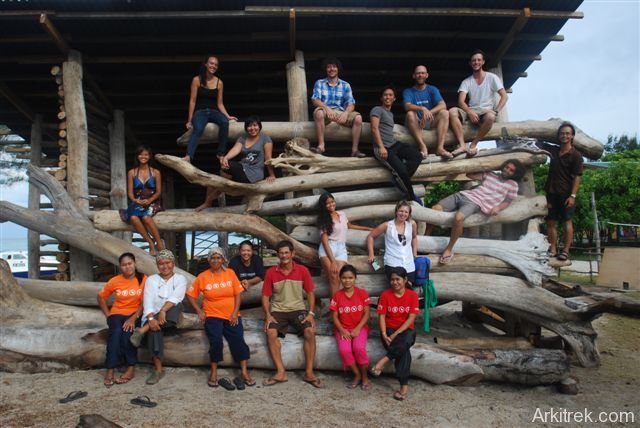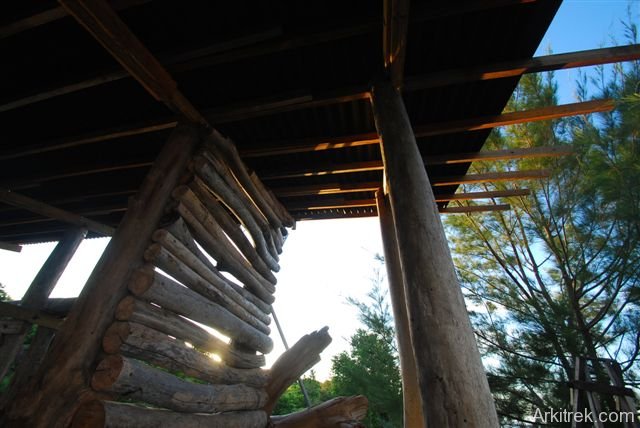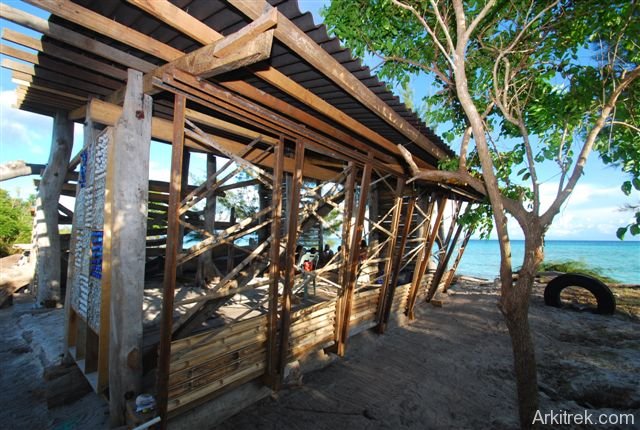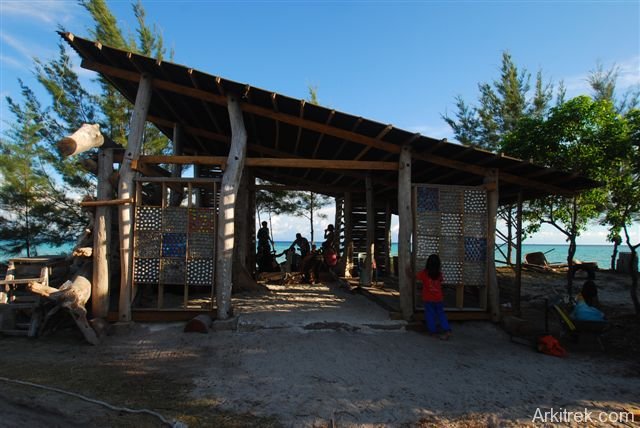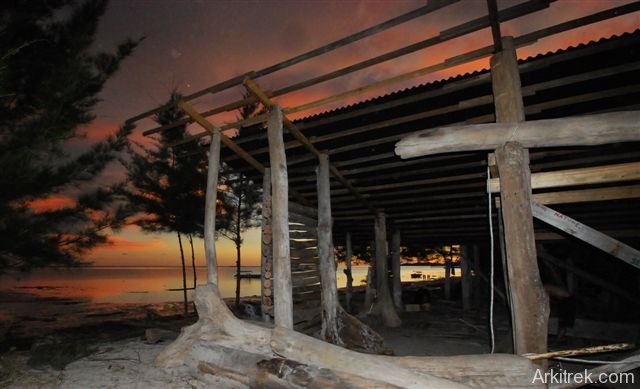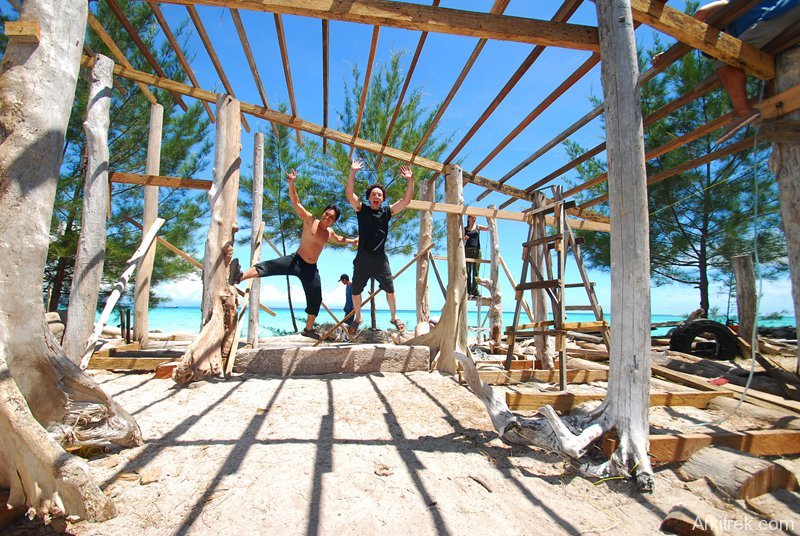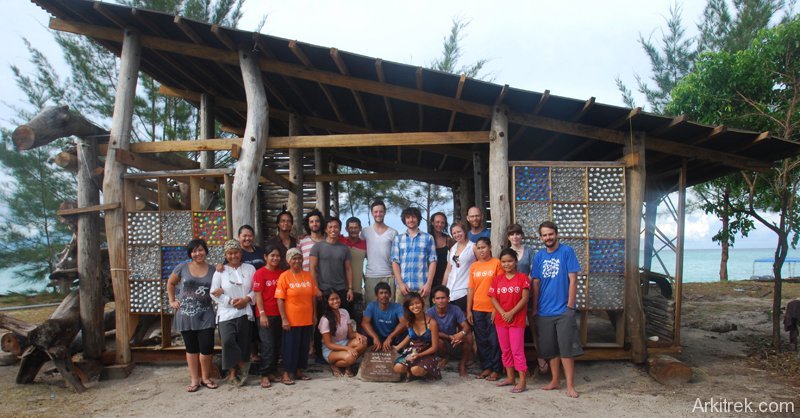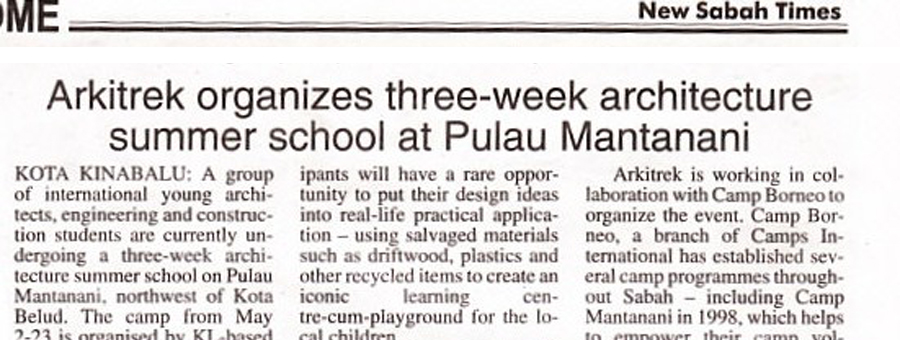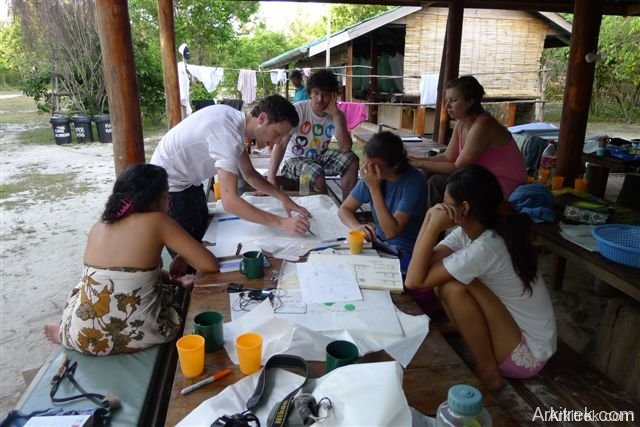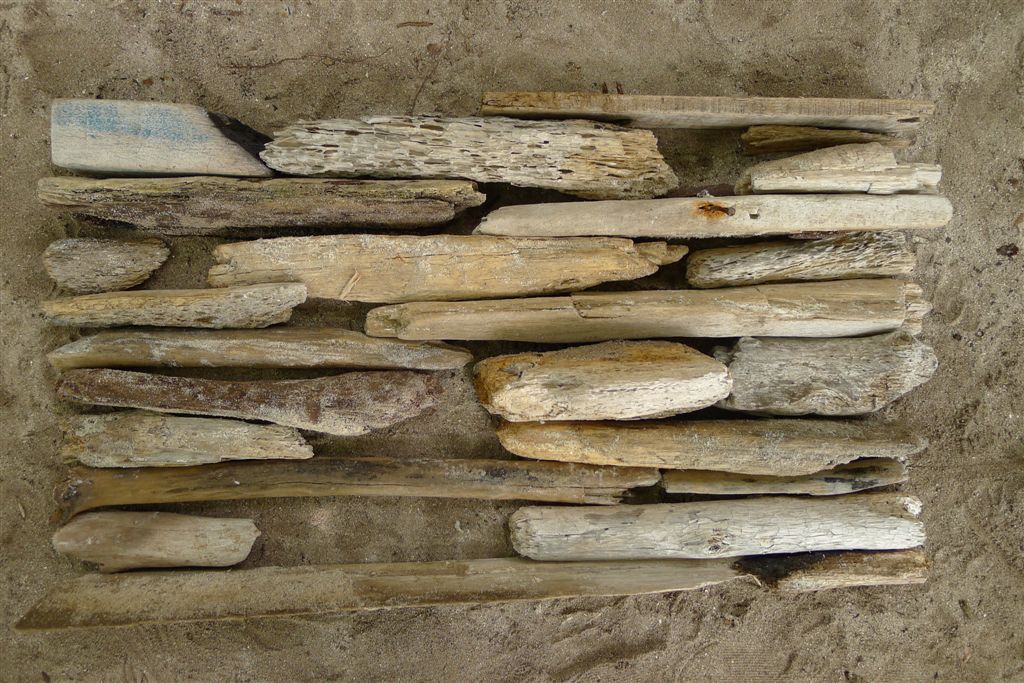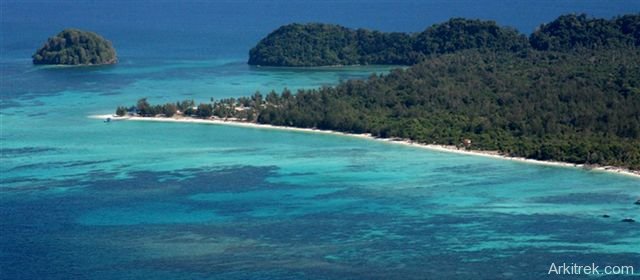Arkitrek Camp: Building communities through Architecture
By Richard Nelson Sokial
Photos courtesy of Arkitrek and Camp Borneo
What kind of environment would you create – if you were stranded on a beautiful tropical island with nothing but driftwood and recycled items for building materials?
This is the design challenge of the first ever Arkitrek Camp held on the idyllic island of Mantanani located in the South China Sea, off the coast of Sabah, Malaysian Borneo.
Mantanani, a remote island located northwest of Kota Belud on Sabah’s West Coast Division, is known for its amazing island scenery, turtle-spotting sights and stellar diving spots. Its crystal-clear waters are one of the few places on earth known to be the habitat and sanctuary of the rare sea cow, known locally as Dugong.
However, like many islands in this region, the island of Mantanani has seen the adverse effects of human activity; floating garbage and debris from the mainland wash up frequently on its pristine sandy shores and fish-bombing activities still prevail around the island – despite ongoing efforts to educate and promote the importance of environmental conservation. Infrastructure facilities on Mantanani are poor; the island community makes a meager living from selling fish to Kota Belud’s land-locked townships. Despite this, the captivating raw beauty of the island – with its glorious golden sunsets casting streaks of long shadows across its secluded whitewashed beaches – creates a lasting impression on those deemed lucky enough to set foot on this proverbial island paradise.
Arkitrek Camp is a 3-week architecture summer school in Malaysian Borneo with participants comprising of young architects, engineering and construction students hailing from US, UK and Malaysia. With training and facilitation provided for by Arkitrek’s facilitators, the camp’s members will have a rare and exciting opportunity to put their design skills and knowledge into real-life practical application. For many of the participants, this is a dream come true – a modern-day take on island living a la Robinson Crusoe.
For the participants, the activities of Arkitrek Camp on Mantanani island will be a chance to address several key issues affecting the island as well as a platform to create awareness of the importance of conservation and how creatively recycled materials can be transformed.
The island is home to a group of predominantly Muslim population known as the Bajau Ubian, who rely on the sea as their main source of income and daily sustenance. With the collaboration of Camp Borneo, a branch of Camps International that has since established a local campsite on the island, Arkitrek Camp hopes to build a learning centre using recycled debris as a showcase of how architecture and sustainable design can be both practical as well as empowering for the local island people.
“The Arkitrek Camp will allow students to design and build a project in response to a real brief on a site in Borneo”, says Ian Hall, founder of Arkitrek and Arkitrek Camp. “Through the experience of realising their design, we aim to equip students with skills that bridge the gap between academia and professional practice. The project brief supports environmental conservation and sustainable development objectives”.
Arkitrek is a KL-based design consultancy motivated by the conservation of the environment and sustainable development and works with social and environmental non-government organizations (NGOs) as well as responsible tourism operators, creating opportunities for work and social enterprise.
The Arkitrek Camp will run for three weeks starting from 2nd-23rd May 2011
and will involve a wide spectrum of activities ranging from identifying and collecting suitable construction materials found around the island, to spatial planning and design and subsequently, the construction and implementation stages of the project. Participants will not only have to cope with the physical challenges and hardships of living on a tropical island but also learning to live and work together as a group to solve arising challenges such as manpower logistics and idea development.
Since their arrival in Sabah, the participants of Arkitrek Camp have been given an introduction to the Land Below The Wind and the city of Kota Kinabalu by way of an architectural city tour as well as an educational walk-through of marine eco-systems at the Green Connection aquarium and science discovery centre located in the heart of the city. They were also treated to a night of local culture, food and hospitality at Kipouvo village, a rural Kadazan settlement in the district of Penampang before being ferried by speedboat to the island of Mantanani, where they were greeted and briefed by the coordinators of Camp Borneo.
With the help of the Mantanani islanders, Camp Borneo has established Camp Mantanani on the island in 1998 to address the education needs of the island’s two villages, the lack of awareness of marine conservation issues, and the improvement of the livelihoods of the local community. Camps International is currently developing its ‘Conservation for Education’ initiatives, with the full backing of the community elders and the Malaysian Department of Education.
“The overall aim of the Camp Mantanani project is to assist the village in working towards a much better stewardship of the marine areas, and will provide the relevant knowledge, expertise and input to see this happen. Camp Mantanani – under the supervision of Camp Borneo – is committed to seeing this project turn into a model conservation-for-education initiative whereby we provide education (either facilities or knowledge, or both) in return for a commitment by the community to protect their environment”, says Melanie Chu, General Manager of Camp Borneo.
“It is hoped that our ongoing beach clean-up activities and data-collection surveys will help to shed light on the issues surrounding Mantanani. Subsequently, we hope to develop a long term initiative to help protect the waters around the island, fostering the community’s participation – whom we believe will ultimately gain from this protection”.
“In our design brief for Arkitrek Camp, the participants have to fulfill three key criteria; we need a place that will be a learning centre, an iconic architectural structure for the island as well as a playground for the local children. We hope that the participants will rise to the challenge and design something amazing for the Mantanani island community”, she said.
Will the participants of Arkitrek Camp be able to step up to expectations? Will they be able to create an empowering community centre using the very basic of available materials? What will the building look like? How will the group solve their construction and limited manpower resources? Most importantly, will they be able to work together? Tune in to find out the outcome of the Arkitrek Camp at Mantanani in an upcoming article of the ongoing project.
Related posts
%RELATEDPOSTS%
Design & Build in Borneo next Spring
Arkitrek Camp, an architecture summer school in Malaysian Borneo is now taking applications for a 3 week camp in May 2011
The Arkitrek Camp is an opportunity for students to design and build a project in response to a real brief on a site in Borneo. Through the experience of realising their design, Arkitrek aims to equip students with skills that bridge the gap between academia and professional practice. The project brief supports environmental conservation and sustainable development objectives and all participants will contribute to the design and construction process.
“Our long term plans in our host communities is for improved infrastructure and opportunities. To be able to gain innovative and new designs from students, whilst also helping to complete the building itself is a win win situation for all.” says Rory Hall, Director of Camps International Asia
The Camp will run for three weeks and is open to architecture, engineering and construction students. Participants with other skills will be considered on a case by case basis. Taining and facilitation will be provided for by Arkitrek staff and visiting experts.
Enquiries will also be considered from architecture schools interested to tailor a camp exclusively to their students and tutors.
ARKITREK CAMP 2nd – 23rd May 2011. £1295 per person excluding flights and insurance. Includes full board, full time facilitation by experienced architects plus a challenging design brief on Mantanani Island, a reef fringed white sand island in the South China Sea.
Expressions of interest and requests for an information pack and booking form may be submitted to ian@arkitrek.com
ABOUT ARKITREK
Arkitrek is a Malaysia based design company specialised in working with social & environmental NGOs, responsible tourism operators and youth organisations. Many of these clients are receptive to providing hands-on learning opportunities to young people in interesting places.
Arkitrek has responded to this by developing expertise in group facilitation and volunteer program management. In 2009 Arkitrek created a site-based intern program which empowers architecture students to work independently outside their comfort zone with the benefit of a support network to ensure a structured learning experience. The Arkitrek Camp takes this model to the next level with an intensive program open to a larger group of students with learning support from full time architectural tutors and facilitators.
ABOUT CAMPS INTERNATIONAL:
Camps International is a UK based volunteer organisation which uses tourism to help tackle community development and environmental issues across Africa and Asia. By bringing volunteers to these parts of the world, Camps International is able to provide opportunities for local employment, worthwhile and long term project work as well as supporting local communities through indirect income generation.
Camps International has been short listed for the “Best Volunteer Organisation” at the Responsible Travel Awards for a number of years, winning the award in 2008. It prides itself on its ethical approach to tourism and volunteering.
Mantanani Driftwood
One month after my last visit, I arrived on Mantanani and was delighted to see the site strewn with impeccable driftwood logs. Albi and his team had scoured the coast and dragged their choice finds through the sea back to the camp site.
Some of the logs still lay tethered at the high water line while others where being diligently planed smooth to resemble nothing like driftwood.
My romantic dreams of water weathered, silvered and twisted timbers would have to be adjusted, another casualty of the cultural conditioning that dictates that anything wild, vernacular and peasant is not compatible with a modern developed nation.
It also took a long while to get around this problem at Borneo Rainforest Lodge. On that job I now have an understanding with the contractor to specify ‘moy liang’ – literally meaning ‘not nice’ in Cantonese.
The success in the use of drifwood logs however, is not in their appearance, but in that we have managed to avoid using posts made out of wonderful and scarce belian wood (see my earlier post).
Belian does not drift, it sinks – and so we can be sure that any timber washed up on the beach will not be belian and therefore would not last as long as belian when stuck in the ground.
To get around this I proposed keeping the post above ground level by bolting it to a steel bracket on a concrete pad. The villagers liked this so much that they wanted to do the rest of the buildings with them.
This would have been great, except that I had plans for the other buildings to use whopping chunks of driftwood instead of foundations.
Albi objected to this on the grounds that all the nice bits of driftwood were earmarked by people and that we’d used up his personal supply on the posts.
I explained that it didn’t matter what they look like as long as they’re heavy and not too badly munched by borers.
“The villagers will laugh at us for using that wood” Albi protested.
I told him to blame it on the white people and then he too could laugh.
The point of trying to use driftwood is that we reduce the transportation of concrete supplies to the island. This is a formiddable headache when all aggregate must be bagged and lugged by hand on and off a small boat. It’s dangerous too if the boatman is tempted to overload with the low volume but heavy cargo.
Whether our builders will find this convenience to be worth the sacrifice of having people laughing at your buildings remains to be seen!
Related posts
%RELATEDPOSTS%


